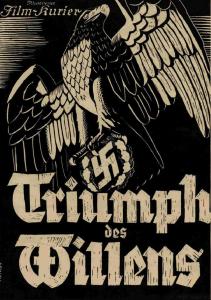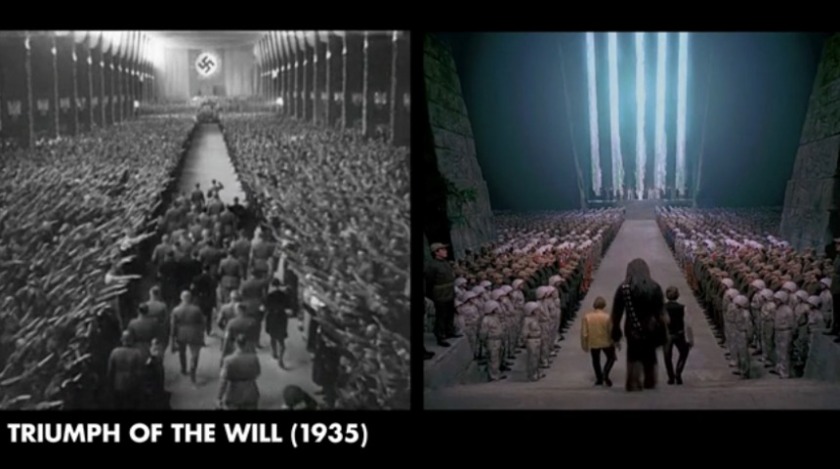 Editor’s Note: This piece was written for a class in which we were instructed to review a film that is considered controversial, acknowledging how it can still be viewed as a work of art despite its controversy.
Editor’s Note: This piece was written for a class in which we were instructed to review a film that is considered controversial, acknowledging how it can still be viewed as a work of art despite its controversy.
What’s peculiar about “Triumph of the Will,” the infamous Nazi propaganda documentary from 1935, is that it doesn’t start with a magisterial shot of fascist grandeur and marching citizenry (although there will be plenty of that), but a peaceful image of soaring through the clouds.
Documentarian Leni Riefenstahl imagines Adolf Hitler’s view as he lands in Nuremberg for 1934’s gathering of hundreds of thousands within the Nazi Party to be “reviewed” by Hitler. When he arrives on the ground, the camera rides along in Der Fuhrer’s car and gets a perspective of almost exactly what Hitler would’ve seen that day in 1934.
No doubt, it’s an incredible sight that we can today recognize as bone-chillingly evil. So many smiling people giving the Nazi salute to their leader, so many star-struck kids gleaming in the sunlight, and all of it so terrifying to today look back and recognize the immense power this monster held over the masses.
But as much as Riefenstahl’s film is made to showcase Germany’s power, it has traces of calling attention to the region’s beauty. Early on the documentary has a travelogue look at the tranquil and old fashioned stone architecture, all the local farmers arriving in traditional lederhosen, the girls in braids and lacy gowns, with the shimmering canals and flags flying gracefully in the wind. You just have to ignore the fact that those flags are all carrying the Nazi insignia.
What’s more, it might be instructive to watch “Triumph of the Will” divorced from its rousing score of victorious marches. With the exception of the film’s several speeches from Nazi elite and Hitler himself, “Triumph of the Will” is practically a silent film, and Riefenstahl’s eye, taking cues from Old Hollywood’s approach to lighting, deep focus cinematography and striking low angles, is not as blindingly celebratory as you might imagine. There is an unconscious, sinister undercurrent to everything you see here, from intense, stoic looks on the faces of the Hitler Youth, to the geometrically precise armies of people gathering in stadiums and plazas that have come to define the look of fascism. In fact, the propaganda proved so powerful and effective, American filmmakers were able to use Riefenstahl’s footage in their own propaganda against the Nazis.
It would be wrong to oversell how impressive “Triumph of the Will” looks, because Riefenstahl’s documentary is by no means a “behind the scenes” account of Nuremberg in 1934. “Triumph of the Will” is exactly the film the government wants you to see, a sparkling, even sanitized look at the Nazi Party. While the film depicts hundreds of thousands celebrating Hitler, it neglects the many more both in fear and in danger of his rise to power. It would be tempting to see “Triumph of the Will” as a powerful historical document, but you quickly realize the film is decidedly one-sided.
That polished, rubbed clean sheen even reflects in the Nazi speeches. Speaking to the Hitler Youth at a massive stadium, the Fuhrer says with all his conviction that the children need to “practice obedience,” “steel yourselves” and “learn to sacrifice,” and you may raise an eyebrow when he says that Germans should be both “peace-loving and strong.” The Nazi leadership all speak of Germany’s greatness in the endurance and fortitude of their culture, economy and jobs. Their words serve as a reminder for how Germany rebuilt itself after the first World War, and Riefenstahl even opens “Triumph of the Will” with a title card that says this all takes place 16 years after the beginning of Germany’s suffering.
While “Triumph of the Will” doesn’t have any of Hitler’s directly inflammatory rhetoric and racism that would prove so terrifying and damning, his speech to close the film evokes and demands a slavish loyalty among the party, an us against them mentality that the enemy must be removed in order for the country as a whole to thrive. You can see how evil can fester under this lens.
But perhaps these images themselves aren’t far different from that of American flag-waving patriotism and militaristic advertisements and propaganda. The Nazis were responsible for some of the greatest evil known to man, but Riefenstahl’s film simply wants to celebrate a country’s power and unity.
Granted, “Triumph of the Will” isn’t exactly thrilling viewing for modern audiences. Have I mentioned the sheer amount of marching? All the parading and mass gathering as Hitler stands firmly in observation makes for the most tedious of pageantry. More interesting would honestly be a documentary about how “Triumph of the Will” was made. Hitler himself said Riefenstahl was his favorite filmmaker (hey, at least the Nazis were progressive in championing female directors) and gave her complete access and free reign to film as she pleased. Riefenstahl deployed 30 cameras and 120 technicians to film the rallies, and the sheer scale and production value necessary to capture everything must’ve required elaborate cranes and detailed, carefully orchestrated tracking shots. Ultimately, the finished, nearly two hour film represents just 3 percent of all the footage Riefenstahl shot.

Even films as massive as “Star Wars” have borrowed liberally from “Triumph of the Will,” and the countless images that have come to define fascism and the Nazis throughout modern popular culture all owe a huge debt to Riefenstahl.
Perhaps the greatness of her propaganda helped stoked the flames of war. Perhaps the world was right to label her a pariah. Or perhaps Riefenstahl’s artistry had the power to put the monstrous evil of Adolf Hitler into perspective.